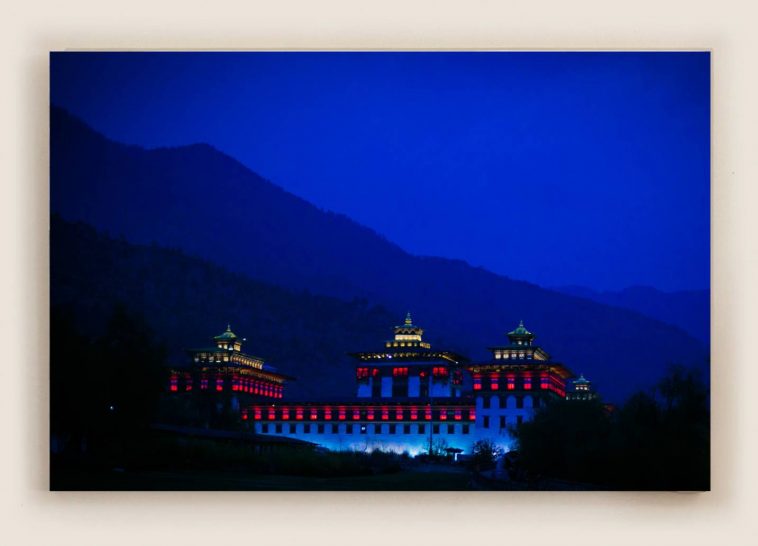The Imperial Palace of Bhutan is a must-see for anyone visiting Bhutan. Perhaps you’re a huge fan of the royal family or simply wish to see one of the country’s biggest architectural landmarks.
The Royal Bhutan Palace has a relatively long and colorful history, and you’ll indeed find something to love inside its large and lavish walls.
If you appreciate the unique cultures from around the world, the royal Bhutan palace will offer you an insightful experience of Bhutan’s prehistoric architecture. Without further ado, here are some interesting Bhutan palace facts that you may not have heard:
#1. The Unique Architecture Of Bhutan Palace
Dechencholing Palace is the pinnacle of Bhutanese architectural brilliance. You are virtually taken back to Bhutan’s ancient times as you enter the palace. This three-story building with lawns and gardens houses Bhutan’s Royal members.
The palace’s interior furniture is thought to have been covered in metal using the centuries-old repousse technique.
Although Thimphu has no airports, this palace has a helipad to provide tourists with quick access. Traditionally, the Bhutan palace exhibits a magnificent architectural homogeneity. And the other palaces are no different.
The shingle roofs and wooden windows that boast of the incredible artistry of Bhutan are distinguishable features of the Bhutan palace.
Most of Bhutan’s palaces were built between the 13th and 17th centuries and are thus architectural monuments.
#2. Building The Colossal Bhutan Palace
The Royal Bhutan Palace was constructed in 1953 upon crowning the Third Dragon King, Druk Gyalpo Jigme Dorji Wangchuck, after his father’s death, Druk Gyalpo Jigme Wangchuck, in 1952.
Unlike many other buildings in Bhutan, this palace is a three-story building with inside furnishings in a traditional Bhutanese style that is distinct from western design.
#3. The Birthplace Of The Fourth Dragon King
Jigme Singye Wangchuck was born to Jigme Dorji Wangchuck and Ashi Kesang Choden Wangchuck on November 11, 1955, at Dechencholing Palace in Thimphu, Bhutan.
Soon after, the Indian officials stationed in Sikkim and their representatives arrived to rejoice in the birth of the Fourth Dragon King and pay their respects to the Royal Family of Bhutan.
A hundred thousand Raksha Thotreng (the wrathful manifestation of Guru Padmasambhava) ceremonies were performed afterward in the palace as an auspicious ritual for Jigme Singye Wangchuck’s enthronement as the Fourth King in 1974.
#4. Major Attractions En-route the Palace
The palace is located on the western bank of the Wang Chhu (Thimphu River), at the northern end of the Thimphu Valley.
You can get to the palace through the Dechhen Lam (street), which goes along the eastern bank of the Thimphu river from Yangchenphug district, past Langjupakha for several kilometers before arriving at the palace.
As you travel to the Royal Bhutan palace, you will come across the Centre for Bhutan Studies, the Royal Banquet Hall, and then pass the India House on the other side of the Wang Chhu river.
You should definitely visit the palace and witness these attractions by booking a Bhutan tour from a reputable tour operator.
#5. There Is A Private Chapel for The Royal Grandmother
Druk Gyalpo’s mother, the Grand Queen Mother Phuntsho Choden (Ashi Phuntsho Choden), also known as Gayum Angay Phuntsho Choden Wangchuck, used to reside in the palace as a Buddhist nun.
However, the current King does not live in this Royal Palace, as the royal residence has moved to the Samteling Palace (Royal Cottage).
Foreign delegations, particularly those from India, are often invited to the palace. Indian ambassadors come to the palace quite often to discuss India-Bhutan relations.
It also serves as a venue for luncheons and banquets for Bhutan’s Heads of State and other dignitaries.
Famous Bhutan Palaces That You Must Visit
#1. Wangduecholing Palace in Bumthang
King Ugyen Wangchuck, Jigme Namgyal’s son and the First Dragon King, was born in Wangdichholing, Bumthang, and made the palace his primary residence.
The manor was built in 1857 on the battle-camp site of Jigme Namgyal, the Trongsa Poenlop. It was Bhutan’s first palace that wasn’t built primarily as a fortress.
The beautiful but dilapidated structure was once a monastic school, but the Bhutan Foundation is working to restore it and turn it into a museum.
#2. Kuenga Rabten Palace in Trongsa
Kuenga Rabten Palace is 23 kilometers from Zhemgang Road. It takes a little less than an hour to get there. It is a two-story structure built in authentic Bhutanese style.
The 3rd Dragon King Jigme Dorji Wangchuck was born in this palace on 2nd May 1928. The 3rd King as a child spent his early life in the Palace.
The Kuenga Rabten Palace is one of Trongsa’s three royal mansions. It is constructed on the banks of the Mangde Chhu River at a height of 1750 meters. It was constructed in 1929.
#3. Ugyen Pelri Palace in Paro
The Ugyen Pelri Palace is a secluded compound built in Paro by the then Paro Penlop, Tshering Penjor, in the 1900s. Today, it is the palace of Bhutan’s Queen Mother, hence closed to the general public.
It is the perfect example of Bhutan’s unique architecture modeled after Guru Rinpoche’s celestial paradise, Zangdo Pelro. If you want to see a bird’s-eye view of the palace, head to the administrative Paro Dzong.
On the road next to Ugyen Pelri Palace, you can see the five stupas built in the memory of Bhutan’s first king, Ugyen Wangchuck.
#4. Punakha Dzong, The palace Of Great Bliss
Punakha Dzong, also known as Pungthang Dewachen Phodrang (Palace of Great Happiness), is a majestic palace with huge spiritual significance. It is the second oldest Dzong or fortress in the country.
Punakha is a 3-hour trip east of the capital, and the place is a spectacular and glorious sight to behold. It is strategically located between two rivers, Pho Chu and Mo Chu, which have distinct color distinctions and rapidity.
It is located in the temperate lowlands of Punakha, and during the spring season, gorgeous lilac-colored jacaranda trees flourish around the dzong.
If you plan to visit Bhutan, make sure to explore these palaces. Visit Norbu Bhutan, the best tour operator that provides a personalized itinerary to make your Bhutan trip a unique experience.
Bottom Line
That’s all there is to it! These are some interesting facts about the Royal Bhutan Palace that you probably didn’t know. Or did you? Do you know any ancient manors and palaces that aren’t mentioned here? Drop in the comments section below.
And if your Bhutan architecture fever simply won’t let up, why not check out What Is The Traditional Architecture Of Bhutan Palace?




